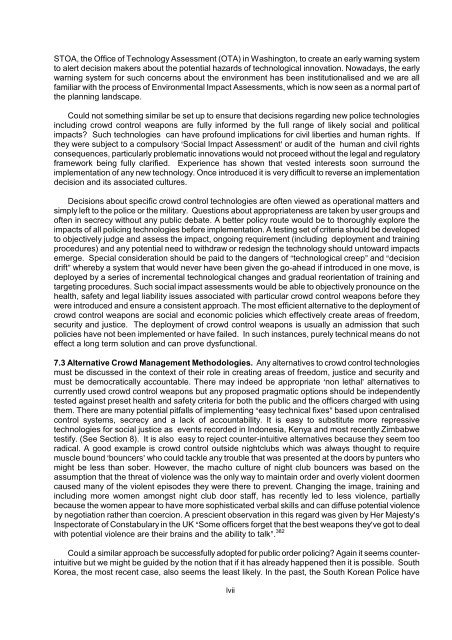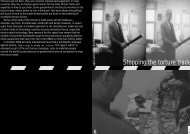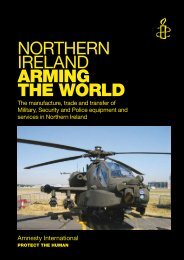CROWD CONTROL TECHNOLOGIES - Omega Research Foundation
CROWD CONTROL TECHNOLOGIES - Omega Research Foundation
CROWD CONTROL TECHNOLOGIES - Omega Research Foundation
Create successful ePaper yourself
Turn your PDF publications into a flip-book with our unique Google optimized e-Paper software.
STOA, the Office of Technology Assessment (OTA) in Washington, to create an early warning system<br />
to alert decision makers about the potential hazards of technological innovation. Nowadays, the early<br />
warning system for such concerns about the environment has been institutionalised and we are all<br />
familiar with the process of Environmental Impact Assessments, which is now seen as a normal part of<br />
the planning landscape.<br />
Could not something similar be set up to ensure that decisions regarding new police technologies<br />
including crowd control weapons are fully informed by the full range of likely social and political<br />
impacts? Such technologies can have profound implications for civil liberties and human rights. If<br />
they were subject to a compulsory Social Impact Assessment or audit of the human and civil rights<br />
consequences, particularly problematic innovations would not proceed without the legal and regulatory<br />
framework being fully clarified. Experience has shown that vested interests soon surround the<br />
implementation of any new technology. Once introduced it is very difficult to reverse an implementation<br />
decision and its associated cultures.<br />
Decisions about specific crowd control technologies are often viewed as operational matters and<br />
simply left to the police or the military. Questions about appropriateness are taken by user groups and<br />
often in secrecy without any public debate. A better policy route would be to thoroughly explore the<br />
impacts of all policing technologies before implementation. A testing set of criteria should be developed<br />
to objectively judge and assess the impact, ongoing requirement (including deployment and training<br />
procedures) and any potential need to withdraw or redesign the technology should untoward impacts<br />
emerge. Special consideration should be paid to the dangers of )technological creep( and )decision<br />
drift( whereby a system that would never have been given the go-ahead if introduced in one move, is<br />
deployed by a series of incremental technological changes and gradual reorientation of training and<br />
targeting procedures. Such social impact assessments would be able to objectively pronounce on the<br />
health, safety and legal liability issues associated with particular crowd control weapons before they<br />
were introduced and ensure a consistent approach. The most efficient alternative to the deployment of<br />
crowd control weapons are social and economic policies which effectively create areas of freedom,<br />
security and justice. The deployment of crowd control weapons is usually an admission that such<br />
policies have not been implemented or have failed. In such instances, purely technical means do not<br />
effect a long term solution and can prove dysfunctional.<br />
7.3 Alternative Crowd Management Methodologies. Any alternatives to crowd control technologies<br />
must be discussed in the context of their role in creating areas of freedom, justice and security and<br />
must be democratically accountable. There may indeed be appropriate non lethal alternatives to<br />
currently used crowd control weapons but any proposed pragmatic options should be independently<br />
tested against preset health and safety criteria for both the public and the officers charged with using<br />
them. There are many potential pitfalls of implementing )easy technical fixes( based upon centralised<br />
control systems, secrecy and a lack of accountability. It is easy to substitute more repressive<br />
technologies for social justice as events recorded in Indonesia, Kenya and most recently Zimbabwe<br />
testify. (See Section 8). It is also easy to reject counter-intuitive alternatives because they seem too<br />
radical. A good example is crowd control outside nightclubs which was always thought to require<br />
muscle bound bouncers who could tackle any trouble that was presented at the doors by punters who<br />
might be less than sober. However, the macho culture of night club bouncers was based on the<br />
assumption that the threat of violence was the only way to maintain order and overly violent doormen<br />
caused many of the violent episodes they were there to prevent. Changing the image, training and<br />
including more women amongst night club door staff, has recently led to less violence, partially<br />
because the women appear to have more sophisticated verbal skills and can diffuse potential violence<br />
by negotiation rather than coercion. A prescient observation in this regard was given by Her Majestys<br />
Inspectorate of Constabulary in the UK )Some officers forget that the best weapons theyve got to deal<br />
with potential violence are their brains and the ability to talk(. 382<br />
Could a similar approach be successfully adopted for public order policing? Again it seems counterintuitive<br />
but we might be guided by the notion that if it has already happened then it is possible. South<br />
Korea, the most recent case, also seems the least likely. In the past, the South Korean Police have<br />
lvii




